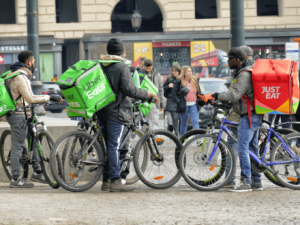The autonomous vehicle industry is dominated by talk of robotaxis, self-driving trucks, sidewalk delivery robots and passenger vehicles like Teslas with automated driving functions. You know, the sexy side of autonomy.
Not much attention has been paid to the type of autonomy Steer Tech, a Maryland-based AV startup, has been pursuing — something the company’s founder and CEO Anuja Sonalker calls “endpoint autonomy.”
Since it was founded in 2016, Steer has focused on providing high-level autonomy for valet parking, a bit of tech that it’s been quietly earning revenue on by selling it to automakers.
Steer is now expanding that use case into the commercial sector through a partnership with Dallas Fort Worth International Airport, which will demonstrate how an automated parking ecosystem can alleviate congestion in traffic pick-up and drop-off areas.
The pilot will combine low-speed automated valet parking, a supervisory parking management system and a digital curb management system. It will test passenger vehicles that have been outfitted with Steer’s AV software and sensor suite.
Steer wants to bring this ecosystem to the endpoint of the logistics supply chain.
“We are focused on the depot side while others are focused on the long haul, and you need both if you want to do end-to-end autonomy,” Sonalker told TC. “Nobody is going to solve everything. Everybody is going to master one area and then work with others to create that end-to-end ecosystem.”
For most hackers, it’s not about the target they’re trying to breach; it’s about using that target as a springboard to something else. Anuja Sonalker, founder and CEO, Steer Tech
Sonalker didn’t cut her teeth solving for low-speed, private-space operational design domains. The founder spent three years at R&D firm Batelle, where she headed its automotive cyber innovation unit, which was later spun out and then acquired by Honeywell. She then set up and led the North American operations of TowerSec, an Israeli automotive cybersecurity startup that was eventually acquired by Harman.
We caught up with Sonalker to talk about the importance of automotive cybersecurity, how automating the “endpoint” can make freight more efficient and why focusing on less glamorous tech can help you build better products.
The following interview, part of an ongoing series with founders who are building transportation companies, has been edited for length and clarity.
TC: Steer is the third startup you’ve been involved with, and the previous two were acquired. Is that the goal for this one?
Anuja Sonalker: With the previous ventures, I will say that the plan was not to get acquired, but that’s how the timing worked out. What I learned from the other previous startups was that the plan has to be bigger. You have to have a vision of where you’re going, and that vision has to be strong and able to resist any kind of upheavals, like a pandemic, in your way.
If there’s an acquisition, it will happen. You can’t stop it; it really is the timing. But I didn’t start with that goal. My goal here is to build a product. The last two startups were focused on automotive cybersecurity. This time, cybersecurity is a major part of the technology, but it is not the whole.
What do you think the biggest pain point is in automotive cybersecurity?
It has changed with time. When I started in this field, the problem really was denial and not realizing that there was a cybersecurity problem, so these vehicles were far more vulnerable. People were able to exploit those vulnerabilities and demonstrate attacks on vehicles that ranged from nuisances to being critical to safety. At the time, the ability to detect vulnerabilities was very important.
Then it changed to: “Okay, now that we have detected it, we have to do something about it.” It changed to prevention. The industry has gone through a tectonic shift in cybersecurity. Every automaker realizes that it’s not whether we are hackable or vulnerable — everything and everybody, given enough time and resources, is penetrable.
So it’s about figuring out that we are being attacked and how we can change that. The idea is to increase the internal resistance of your vehicles, and now the issue is really about designing the right amount of cybersecurity into your vehicles. Not too much, and not too little.










